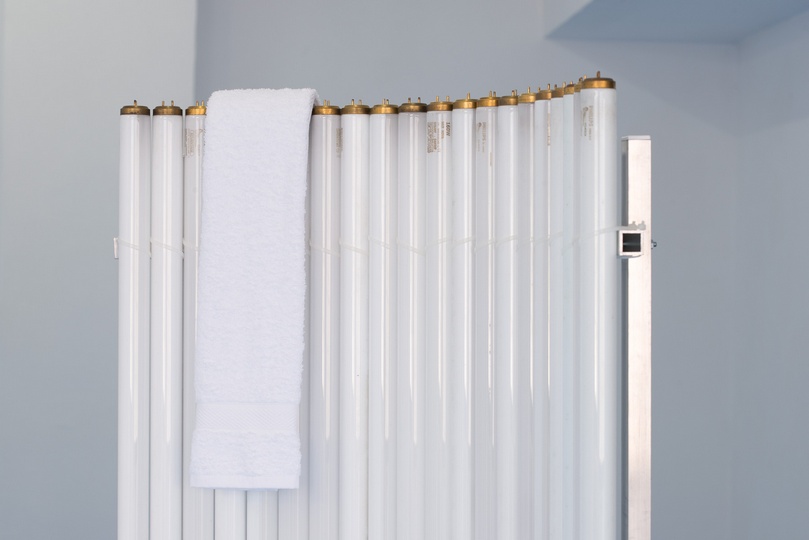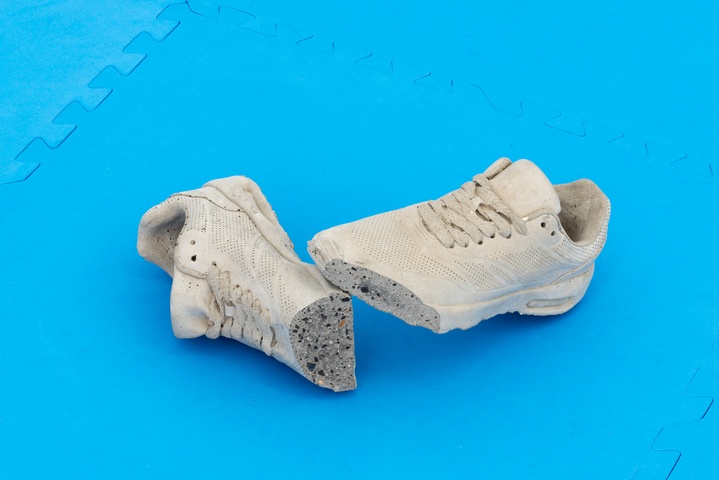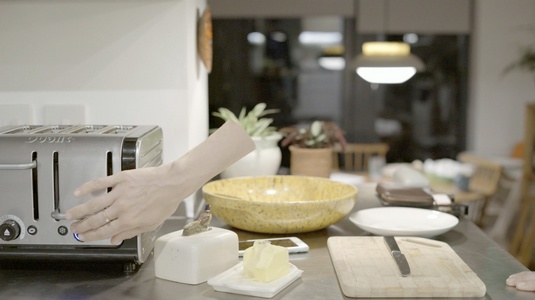Rowena Harris
22.09.2017 – 22.12.2017
Exhibition Views

Soft Boundaries, installation view, The Gallery Apart Roma 
Soft Boundaries, installation view, The Gallery Apart Roma 
Soft Boundaries, installation view, The Gallery Apart Roma 
Soft Boundaries, installation view, The Gallery Apart Roma 
Soft Boundaries, installation view, The Gallery Apart Roma 
Pelt, diptych#1, 2017, embossed copper, 40 x 30 + 28,5 x 20 cm 
Golden Brown Texture Like Sun, 2017, used sun tanning bulbs, aluminium, towel, 180 x 75 x 60 cm, detail 
Golden Brown Texture Like Sun, 2017, used sun tanning bulbs, aluminium, towels, 11 x 191 x 35 cm, detail 
Pelt, 2017, CGI animation (shown in HD), 31’45” (looped), Ed. 5 + 1AP 
A room within which the computer can control the existence of matter, 2017, HD video, stereo sound, 10’21”, Ed. 5 + 1AP 
A room within which the computer can control the existence of matter, 2017, HD video, stereo sound, 10’21”, Ed. 5 + 1AP
Works

Golden Brown Texture Like Sun, 2017, used sun tanning bulbs, aluminium, towel, 180 x 75 x 60 cm 
Golden Brown Texture Like Sun, 2017, used sun tanning bulbs, aluminium, towel, 180 x 75 x 60 cm 
Golden Brown Texture Like Sun, 2017, used sun tanning bulbs, aluminium, towel, 53 x 178 x 56 cm 
Golden Brown Texture Like Sun, 2017, used sun tanning bulbs, aluminium, towel, 53 x 178 x 56 cm, detail 
Golden Brown Texture Like Sun, 2017, used sun tanning bulbs, aluminium, towels, 11 x 191 x 35 cm 
Golden Brown Texture Like Sun, 2017, used sun tanning bulbs, aluminium, towels, 183 x 25 x 25 cm 
At The Edge of the Frame, 2017, polished concrete, edition of 10 with different cut each, 10x22x10 cm c.a. 
At The Edge of the Frame, 2017, polished concrete, edition of 10 with different cut each, 10x22x10 cm c.a. 
At The Edge of the Frame, 2017, polished concrete, edition of 10 with different cut each, 10x22x10 cm c.a. 
Just Past The Frame, 2017, polished concrete, variable dimensions 
Pelt, triptych, 2017, embossed copper, 40 x 30 cm each 
Pelt, diptych#1, 2017, embossed copper, 40 x 30 + 28,5 x 20 cm 
Pelt, diptych#2, 2017, embossed copper, 40 x 30 + 28,5 x 20 cm 
A room within which the computer can control the existence of matter, 2017, HD video, stereo sound, 10’21”, Ed. 5 + 1AP 
A room within which the computer can control the existence of matter, 2017, HD video, stereo sound, 10’21”, Ed. 5 + 1AP 
A room within which the computer can control the existence of matter, 2017, HD video, stereo sound, 10’21”, Ed. 5 + 1AP 
A room within which the computer can control the existence of matter, 2017, HD video, stereo sound, 10’21”, Ed. 5 + 1AP 
Pelt, 2017, CGI animation (shown in HD), 31’45” (looped), Ed. 5 + 1AP 
Pelt, 2017, CGI animation (shown in HD), 31’45” (looped), Ed. 5 + 1AP
Soft Boundaries describes the current state in which we live – a state where experiences, effects and understanding gained from the digital realm move freely into our tangible reality. Boundaries that may once have been neatly defined, are now soft and pliable – they are superficial membranes that positively support the act of osmosis between digital and material. The body is at the centre of Harris’ investigation into this area. Through considering the concept of ‘corporeal schema’ (or body image), which can be understood as the body’s capacity to be open to, and intertwined with the world, and where body image is not fixed or rigid but adaptable to the myriad of tools and technologies that may be embodied[i], she considers the contemporary body as one not limited by the boundary of our skin – our bodies have become media and media are reconfiguring our matter[ii].
Can our everyday technologies alter our perception of touch? – our perception of materiality? – our perception of where the limits of our own bodies lie?
The exhibition interprets these question poetically, perhaps phenomenologically, as a brief moment when bodily perception suddenly goes awry. Akin to sitting but the seat is lower than you expect; to expecting an extra step ascending or descending stairs; when you expect the ground to be hard but it is soft beneath your feet. Being subject to a soft boundary is akin to falling when you least expect.
Harris’ practice is informed by the murky area between materiality and digitality, considered from the site of the human body, and her work spans both sculpture and digital forms. In the exhibition, she calls the viewers own body into the question through an experiential element – a soft foam flooring that gives beneath one’s feet. She also introduces the idea of skin as a phantom presence, through sculptures ‘Golden Brown Texture Like Sun’ that are comprised of used and expired sun tanning bulbs – bulbs which have acted upon countless human bodies – transferring UV rays into their skin. These ‘countless skins’ become veritable ghosts in the exhibition, and golden, cone shaped eye protectors that are a noticeable feature of tanning salons, litter the gallery floor.
The series ‘Pelts’ comprised of thin copper surfaces, alongside a film in the basement also titled ‘Pelt’, focuses on digital rendering of skin, where skin, in 3D modelling as well as 3D printing (colloquially called ‘pelts’ or (animal) hides, by programers), is nothing other than pure surface – depth is rendered as an illusion as pixels in a jpeg, and wrapped like a blanket on a digital 3D form. In the sculptural works, Harris imagines a conversion through embossing the jpeg into a surface, creating works that slip between surface and three-dimensional form.
The sculptural series ‘At the Edge of the Frame’, which are cast concrete shoes, Harris has applied a digital gesture of ‘cropping’, familiar from Photoshop, Instagram and similar, to material form. One clean line dissects each pair of shoes, and through this she creates a form that plays with our familiar understanding of digital imagery, whilst with the same gesture, reveals the sculptures solid concrete interior and their brutal ‘there-ness’ of matter.
In the basement of the gallery the film ‘A room within which the computer can control the existence of matter’ takes it’s title from a quote by Ivan Sutherland, creator of the first virtual reality (VR) machine. The film considers the potentiality of digital experience to reform how we understand our own human body. It combines research on ‘corporeal schema’ – embodiment within virtual reality – and Harris’ long-standing interest in virtual phantom limb therapy (VPLT)[iii], and probes whether our digital experiences could be considered in the same vein as that of VPLT and VR embodiment experiments in altering our perception of our bodily state, but rather subsumed and unnoticed as part of our everyday reality.
[1] 1994, E. Grosz, Volatile Bodies: Toward a Corporeal Feminism, Allen & Unwin, AU
[1] 2015, J. Laia, Hybridze or Disappear, Mousse Publishing, Milan, IT
[1] VLPT or Virtual Phantom Limb Therapy, is given to amputees to relieve pain in a phantom limb. The therapy is essentially an augmented reality, where the amputee, with the aid of applied sensors on the stump, a camera and image on a monitor, re-experience a virtual version of their missing limb, and train their brain to accept the virtual limb as part of their physical body.
Soft Boundaries delinea l’attuale stato in cui viviamo – uno stato in cui le esperienze, gli effetti e la comprensione acquisiti dall’universo digitale, si muovono liberamente all’interno della nostra realtà tangibile. I confini che una volta potevano essere ben definiti, ora sono molli e flessibili – sono membrane superficiali che sostengono positivamente l’atto dell’osmosi tra il digitale e il materiale. Al centro della ricerca di Harris vi è il corpo. Attraverso la riflessione sul concetto di “schema corporeo” (o immagine corporea), che può essere interpretato come la capacità del corpo di aprirsi a, e intrecciarsi con il mondo, e dove l’immagine corporea non è fissa o rigida ma adattabile alla miriade di strumenti e tecnologie che possono essere incarnate[i], l’artista considera il corpo contemporaneo non limitato dal confine della propria pelle – i nostri corpi sono diventati dei media e i media stanno riconfigurando la nostra materia[ii]. Le tecnologie quotidiane di cui disponiamo sono in grado di alterare la nostra percezione del tatto? – la nostra percezione della materialità? – la nostra percezione di dove risiedono i limiti dei nostri stessi corpi? Interrogativi che la mostra si propone di interpretare in chiave poetica, forse fenomenologica, come un breve momento in cui la percezione corporea improvvisamente fallisce. Come stare seduti ma la sedia è più bassa di quanto previsto; come aspettarsi un gradino in più nel salire o scendere le scale; come quando ci si aspetta che il terreno sotto i piedi sia duro ma poi si rivela morbido. Essere soggetto a un confine molle è come cadere quando meno te lo aspetti.
La pratica artistica di Harris è pervasa da uno spazio vago sospeso tra materialità e digitalità, considerate dal punto di vista del corpo umano, e la sua opera abbraccia sia opere scultoree che digitali. Nella mostra, l’artista coinvolge lo stesso corpo dello spettatore attraverso un elemento esperienziale: un soffice pavimento in schiuma che spunta sotto i piedi dell’astante. Introduce inoltre l’idea di pelle come una presenza fantasma, attraverso le sculture “Golden Brown Texture Like Sun” composte da lampade abbronzanti utilizzate e scadute – lampade che hanno operato su infiniti corpi umani – trasferendo raggi UV nella loro pelle. Queste “pelli infinite” diventano veri fantasmi nella mostra, mentre maschere protettrici per gli occhi, dorate e dalla forma conica, che rappresentano un tipico oggetto dei centri estetici di abbronzatura, ricoprono il pavimento come spazzatura.
La serie “Pelts” composta da sottili superfici in rame, accompagnata da un film nel piano interrato anch’esso intitolato “Pelt”, è incentrata sulla resa digitale della pelle, dove la pelle in modellazione e stampa 3D (colloquialmente chiamata “pellame” dai programmatori) non è nient’altro che pura superficie – la profondità è resa in modo illusorio come pixel in una foto jpeg, e avvolta come una coperta su un formato digitale 3D. Nelle sculture, Harris immagina una conversione incidendo in rilievo l’immagine jpeg all’interno di una superficie, realizzando opere che scorrono tra superficie piana e forma tridimensionale. Nella serie di sculture “At the Edge of the Frame” , composta da scarpe in calcestruzzo, Harris ha applicato l’azione digitale del “cropping”, comune a Photoshop, Instagram e simili, alla forma materica. Una linea netta disseziona ciascun paio di scarpe, creando così una forma che gioca con la nostra comprensione familiare dell’immaginario digitale, mentre con lo stesso gesto rivela l’interno in cemento delle sculture e l’“essere” brutale della materia.
Nel piano interrato della galleria il film “A room within which the computer can control the existence of matter” prende il titolo da una frase di Ivan Sutherland, creatore del primo visore di realtà virtuale (VR). Il film riflette sulle potenzialità dell’esperienza digitale di riformare il modo in cui comprendiamo il nostro corpo umano. Unisce la ricerca sullo “schema corporeo” – materializzazione all’interno della realtà virtuale – e l’interesse di lunga data di Harris nella terapia virtuale del dolore dell’arto fantasma (virtual phantom limb therapy -VPLT)[iii], e indaga se le nostre esperienze digitali possano essere considerate sulla stessa scia della VPLT e degli esperimenti di personificazione di VR nell’alterare la percezione del nostro stato corporeo, ma inglobate e inavvertite quale parte della nostra realtà quotidiana.
[1] 1994, E. Grosz, Volatile Bodies: Toward a Corporeal Feminism, Allen & Unwin, AU
[1] 2015, J. Laia, Hybridze or Disappear, Mousse Publishing, Milan, IT
[1] La VLPT o Virtual Phantom Limb Therapy, è somministrata a soggetti cha hanno subito l’amputazione di un arto per alleviare il dolore percepito in un arto fantasma. La terapia è essenzialmente una realtà aumentata, dove il soggetto amputato, con l’aiuto di sensori applicati sul moncone, a videocamera e l’immagine su un monitor, rivive una versione virtuale di sensazione di recupero del proprio arto mancante, e istruisce il proprio cervello ad accettare l’arto virtuale quale parte del proprio corpo fisico.
share on